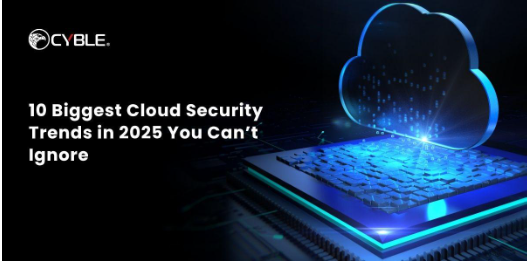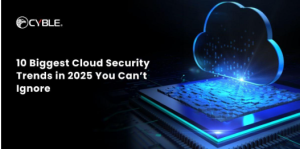10 Biggest Cloud Security Trends in 2025 You Can’t Ignore

Cloud computing has transitioned from being just part of the business to the foundational level of most new organizations. From small startups to enterprise companies, almost all use some version of a cloud platform to store data, run applications, and deliver services at scale. However, as adoption ramps up, so do the threats. That’s why it’s important to understand the Cloud Security Trends 2025. It’s not just nice-to-know info; it’s essential.
The global market for cloud security is evolving at breakneck speed. Cloud Security Market growth, by 2025 the estimated revenue will be $2.70 billion and a staggering CAGR of 24.07 % projected through 2030.
That growth will have the market at $7.93 billion at the end of the decade and in the U.S. the cloud security market is projected to generate approximately $1.2 billion. As this adoption takes hold, it’s paramount that your company keeps pace with the quickly emerging cloud security trends 2025 in order to stay secure and compliant.
Let’s take a closer examination at the 10 biggest Cloud Security Trends in 2025 you cannot afford to ignore.
- AI-Powered Threat Detection is on the Rise
AI is changing cybersecurity in all perspectives, and cloud protection is no exception. In 2025, AI-based security tools will hold a prime position among key cloud security trends. Such systems keep evolving through new information changes to detect strange behavior that may hint at an ongoing attack.
For instance, AI tools can immediately flag or block a login attempt from an unusual location at an odd hour. This kind of reactive detection becomes paramount when dealing with large and complex cloud environments where human oversight alone is insufficient.
- Cloud Security Posture Management (CSPM) Is a Need to Have
With the rise of cloud computing comes an increased risk of misconfiguration, one of the leading causes of breaches. Cloud Security Posture Management CSPM tools come into play by monitoring and managing cloud environments to ensure compliance and security.
Solutions designed for massive scale combine CSPM capability by integrating into a broader threat intelligence platform.
This enables organizations to more proactively identify vulnerabilities, automate risk management, and enforce real-time compliance across multi-cloud and hybrid environments. For businesses experiencing rapid growth, this is less of a luxury and more of a “need to have” today.
- Zero Trust Architecture Goes Mainstream
“Never trust, always verify” isn’t just a slogan anymore—it’s a security standard. Zero Trust ensures that every user and device, no matter how familiar, must continuously prove they’re trustworthy.
In 2025, Zero Trust will become a cornerstone of future cloud security trends 2025. Think of it like a high-security office building: even if you work there, you still need a badge scan and a security check before entering sensitive areas. The same principle now applies to cloud applications and data access.
- Multi-Cloud Security Strategies Gain Ground
Most companies are no longer tied to a single provider. They use multiple cloud platforms to optimize performance, cost, and resilience. But that flexibility brings complexity—and new risks.
2025 Cloud Security Trends show that multi-cloud security strategies will focus on visibility and centralized control. Security teams will rely on unified dashboards and automated policies to manage threats across all platforms, reducing blind spots and human error.
- Data Privacy and Compliance Take Center Stage
With evolving regulations like the and new data protection acts worldwide, compliance isn’t optional. Businesses face heavy fines and reputational damage for mishandling customer data.
In the Cloud Security Trends 2025 report, compliance automation tools are expected to grow significantly. These solutions automatically track and enforce regulatory requirements, ensuring data is stored, processed, and shared according to the latest legal standards.
- DevSecOps Becomes a Business Priority
Security is shifting left meaning it’s being built into the development process from the very start. This approach, known as DevSecOps, ensures vulnerabilities are caught before they make it into production.
For instance, developers integrating security testing directly into CI/CD pipelines can identify and fix misconfigurations early. In 2025, emerging cloud security trends 2025 will see DevSecOps adoption surge, as organizations aim to reduce risks without slowing innovation.
- Identity and Access Management (IAM) Evolves
Compromised credentials remain one of the most common causes of cloud breaches. That’s why key cloud security trends 2025 focus heavily on identity security.
We’re seeing a shift toward adaptive authentication, where access decisions change dynamically based on context—like location, device type, and user behavior. For example, a login from a new device might trigger multi-factor authentication (MFA), while a known device on a secure network may not.
- Container and Kubernetes Security Takes the Spotlight
With the rapid growth of microservices, containers and Kubernetes have become essential for deploying cloud-native applications. But they also expand the attack surface.
Cloud Security Forecast 2025 shows an increasing focus on securing containerized environments. Expect tools that provide runtime protection, vulnerability scanning, and real-time monitoring specifically designed for containers and orchestration platforms.
- API Security Moves Up the Agenda
APIs are the glue that connects cloud services—but they’re also a prime target for attackers. Unsecured APIs can lead to massive data breaches.
In the Top Cloud Security Trends 2025, API security will be a top priority. Automated discovery, continuous monitoring, and strict authentication policies will become standard to prevent API abuse and data exposure.
- Security Automation and Orchestration Become Essential
Manual security responses are no longer practical in complex cloud environments. The volume of alerts is too high, and attackers move too fast.
That’s why Cloud Security Trends for 2025 point to widespread adoption of security automation and orchestration tools. These solutions streamline incident response by automatically isolating compromised accounts, blocking suspicious IPs, and triggering alerts—all in real time.
Conclusion
The Cloud Security Trends in 2025 clearly show one thing-the cloud threat landscape is getting more sophisticated, and so are the solutions. From AI-driven defences to Zero Trust models, organizations must change their strategy to stay ahead. And while technology forms a big part of the success, culture and process are equally important.
Security should be factored into every decision, from development through deployment into the actual day-to-day operation. Solutions like ’s Cloud Security Posture Management (CSPM) exemplify how companies can approach the problem in a unified and proactive manner. Real-time compliance, risk management, and threat detection are all integrated to help companies fortify their defenses without hindering innovation.
The cloud will continue to power digital transformation, but only those company who changes themselves according to Cloud Security Trends 2025 will truly flourish. As the market continues to grow and threats continue to change, staying aware and prepared has become not just an option but a necessity for business resilience.






